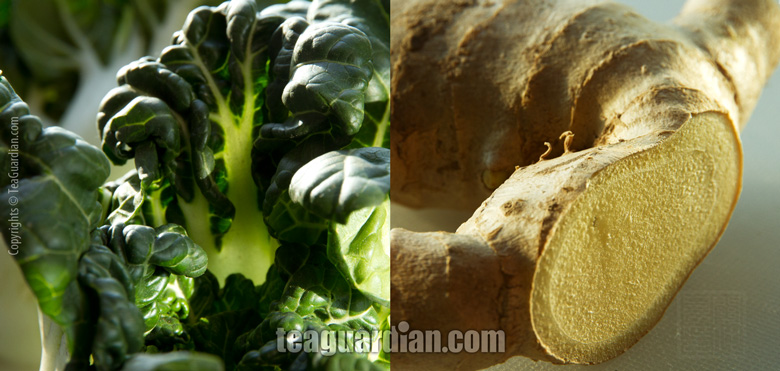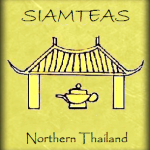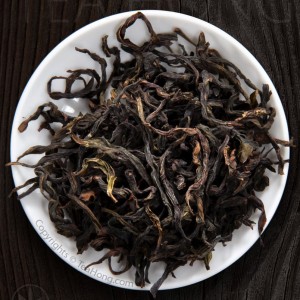TCM: What it Has to do with Tea
Traditional Chinese Medicine
Traditional Chinese Medicine (TCM) is a system of wellness and medical practice that is based on the holistic view of the human body operating within the energy of Nature. Therefore, its fundamental concepts of yin yang and the five elements are also those for understanding Nature and the cosmos. Beyond that, however, there is a complex system of knowledge of the physiology that is not based on anatomical physicality but rather energy and functional manifestations. Its unique diagnostic means, as well as its therapeutic approaches, such as Qi gong, acupuncture and use of herbs have been so developed.

A traditional saying, these four characters sum up a basic common sense in traditional Chinese wellness system — yi shi tong yuan — medicine and food are of the same source
It is believed that TCM has been in practice for millenniums. The world’s earliest existing clinical textbook, “Treatise on Colds and Fevers” was published around 200 A.D. by the influential physician Zhang Zhong Jing and is still being studied.
TCM is practiced widely in all Chinese societies alongside with modern medicine. It has substantial influence in healthcare in other East Asian countries such as Korea and Japan. Studies and principles of TCM are also utilized in many other fields to contribute to general medicine, health food, culinary arts, and even massage and other health spa processes, such as foot shiatsu (1). In some cities in the West, TCM is an alternative approach to modern medicine. It is becoming more popular because more people are beginning to see what it can do.
Bok choi & ginger: the meaning behind the pair
TCM is also a set of traditional common sense in healthy living, although it is getting less “common” in recent generations. Food is an important component in this tradition. The various ingredients are viewed no differently as those in herbal medicine; everything has its own medicinal character and should be consumed accordingly. A four-character saying sums it up — yi shi tong yuan — medicine and food are of the same source.
Here is one simple example to illustrate that good TCM understanding of food ingredients helps to maximize the benefits of culinary arts:

The daily Chinese vegetable that is a very healthy ingredient but yet often misused to cause slight discomfort.
Bok choi (aka bai cai, pak choi, Chinese cabbage etc), a common leaf vegetable that belongs to the same species as broccoli, Brassica oleracea, and contain anti-cancer substances such as Indole-3-carbinol. It has a very high content of vitamins A&C and ranks second (after watercress) in Powerhouse Fruits and Vegetables in nutrients density by the USA Centers for Disease Control and Prevention (2).
After all, it is a delicious ingredient in daily meals for southern Chinese, used popularly in soups, stir-fry and steamed dishes. It is chilling in TCM nature; it promotes urination, clear breath, bowel regularity, anti-inflammatory function and immunization against respiratory infections.
Ginger, which is another daily ingredient, is also a common herbal formula component. It is warm in TCM nature and one of its key functions is to dispel the “wind” kind of toxins. It is often added to bok choi recipes to balance the vegetable’s chilling nature and add depth to the taste. A person who has a weak stomach or during a weaker condition caused by lack of fire energy, such as during menstruation, should avoid bok choi prepared without ginger or other balancing ingredients, or she will be “over-chilled” to contract other complications, such as dizziness, gastric gas, and loss of appetite and energy. This may explain why some people sometimes would feel sick after eating certain vegetables without a balancing ingredient.

The common ginger root that is a daily ingredient in cooking and yet often overlooked and not well used to maintain the energy balance in the dish.
The reader has to be reminded that different vegetables have different TCM characters. That is why a varying and balanced diet is important in the long run.
Tea: as varied as vegetables
Tea is a daily consumption item and because of the amount we normally ingest is regular and thus significant, it is to our benefits to understand its TCM nature in addition to all its other health promoting capabilities that modern science has discovered. Although we are by no means experts in TCM, a few concepts that we have used in this site are briefly listed here for the reader’s reference. To find out more about TCM, please do extend your reading beyond this site.
Tea is a much taken for granted item as much in the East as in the West. The different TCM nature of each of its great varieties is yet to be studied by TCM specialists. The TCM nature of each tea that we may discuss here is based entirely on our observation and experience. Although individual TCM professionals and even some medicine researchers from the West agree with what we understand, it is important that TCM scientists put in their efforts to make the understanding of tea a lot more complete.
Please be advised that, like tea, there are a lot of information out there of irregular quality, so is that for TCM. Unlike tea, TCM is a much larger conglomerate of various fields of knowledge and to understand it as a consumer, it does take a little effort. We have listed a few internet sites here that we think would be helpful for basic reading in the English language.
- An easy general reading by a healthcare company in Hong Kong (3):
http://www.shen-nong.com/eng/front/index.html - Register of Chinese Herbal Medicine, UK
http://www.rchm.co.uk/AboutCHM.htm - The National Center for Complementary and Alternative Medicine, US
http://nccam.nih.gov/health/whatiscam/chinesemed.htm
footnotes
1. Foot massage, which is more popular for commercial reasons, is a de-generation of foot shiatsu. The latter requires accurate and in-depth understanding of the acupunctural points of the foot and shiatsu experience to attain any desired health effects. Foot massage, on the other hand, is easy to learn but its effects much less obvious. Bare-foot pebble path, which is another re-incarnation of foot shiatsu, is popularly seen in Asian countries, such as recreational parks in Hong Kong. Practiced regularly, it can promote health quite effectively.
2. J Di Noia, Defining Powerhouse Fruits and Vegetables: A Nutrient Density Approach, Preventing Chronic Disease, Volume 11 — June 05, 2014, Center for Disease Control and Prevention, USA doi: http://dx.doi.org/10.5888/pcd11.130390
3. We are not associated or in any other way related to this entity. We simply cannot find that many sites worth reading in the English language on the topic.












Hi there
I wonder if you could help me, I would like to know if there is a certain tea or diet for Eczema
Hello NJ,
I shall speak from the TCM perspective, and in general. The condition in each person is different so the only way to find proper care is to visit a well qualified TCM practitioner who is able to customise a treatment for you.
Usually eczema is a manifestation of dampness evil. A person who has one or more of these issues is more vulnerable to the outbreak of dampness evil:
weakness in the faculty of the kidney
weakness in the faculty of the spleen
weakness in the faculty of the lung
Please note that these are concepts of the organs in TCM terms and not necessarily referring to the anatomical idea of the physical organs. The faculty of kidney is responsible for filtration, excretion, moisture conservation, vitality and libido. It is interlinked with the two above mentioned faculties.
Normally a TCM doctor will do two things after the cause is diagnosed:
1. to prescribe a combination of herbs according to the condition of the patient to repel the dampness evil
2. to ask to the patient to change habits that originally attracted the evil
After a certain amount of time, maybe a couple of days, maybe a few months, depending on the recovery and condition, a good doctor will follow up with a 3rd action:
3. prescribe herbs and perhaps diet to strengthen to weakened faculty that lost defence against the outbreak
These are some of the usual causes that weaken the faculty of kidney:
Staying up late
Stress
Strong or prolonged intake of medicines/drugs/supplements
Alcoholism
Excess coffee
Excess beer
Excess sugar
Over nutrition
Unbalanced diets
Under nutrition
Not enough exercises
Before you recover, it is advisable, in general terms, to stay away from these things:
Cold drinks
Sugary food and drinks
Alcohols
Coffee
Stress
Late nights
Overly spicy food
Body care products with fragrance and alcohol
Constrain intake of animal grease and protein. Increase plant fibre and varieties of cooked veggies and other plants in the diet. Eat and drink at moderate pace.
Go to bed at 11 pm the latest and exercise regularly and moderately.
These above help to re-regulate the yin energy flow and hopefully mend the faculty of kidney.
Prepackaged herbal combinations that are labelled as “ridding dampness” are perhaps good for ordinary people. They are almost always too cool/cold in TCM nature for the weakened ones. Usage of such things may further complicate the symptoms. A consultation with the TCM doctor is the best way for a customised prescription.
Tea of Camellia sinensis, when used correctly, helps to rid the dampness evil while replenishing liquid in the body. It also regulates excessive blood sugar and fats to lessen the recurring of eczema.
A person who is weaker in the aforesaid faculties should use a tea that is TCM neutral to neutral cool. Stay away from shu cha pu’er and black tea, both of which are damp in TCM nature. Green tea, green oolongs and fresh white teas are all too cool for the weakened faculty. Stay away from them as well.
The only varieties usable with moderation are classic style Phoenix and Wuyi oolongs that are not over-fired. Occasional use of well matured white teas and shengcha is acceptable.
Never drink strong tea, or tea that has turned cold, or tea with milk and sugar in such situation.
Hello, Mr.Leo. Thank you for more detailed informations via this comment on TCM on tea. After reading this, I have 2 following questions:
1) Unfortunately, for the most people on the planet, shengcha and white tea would be more accessible options than Phoenix and lightly baked Wuyis.. Thus it would be helpful to explain a bit more detailed guidance of drinking the sheng and the white.; i.e. How often do you mean by “occasional use” and how long should they be matured, for least safety of the most people.
2) I am recently awared that in Teahong’s website, Nepali black(or technically, semi-oxidized ) teas are categorized as TCM -neutral ones. Can semi-oxidized (mostly first flush) teas from Nepal and Darjeeling act as alternative of Phoenix for safely getting rid of dampness evil? If so, it would be great since they are usually cheaper(Nepali) or more remotely accessible(Darjeeling). i.e. Can they role as what Da Baiye is to Song Cultivar, for TCM purpose?
@Felix, here is my response to your two questions:
1/. People can be susceptible to dampness evil to various degrees. If I tell you how frequent to use a tea that can cause both cold and damp energy in a specific way that suits all people, I will be lying. In another word, some can drink it all the time while some have to abstain from it. Most others in varying frequency depending on each’s own TCM conditions.
As for how long a shengcha can matured to tone down its cold-dampness, or a white tea, it will be a long answer. A short one will be 3 years, provided all good practices. Fujian white tea between 6 months to 3 years, dependent on the made and provided all good practices.
BTW, in quite a few places on Planet Earth, shengcha is rarely heard of and Wuyi is far more popular. 😉
2/. You are very smart to have named two varieties that are very close to Phoenix oolongs in all TCM natures. If you can’t access traditional oolongs like Phoenix or Wuyi, Nepali and Darjeeling semi-oxidised are acceptable alternatives, although to lesser effects. Stay away from those very green ones though, and use the whole leaf version.
While we are at it, I’d like to point out that dampness evil can be attracted through agents of either a TCM-cold or TCM-neutral nature, or anywhere in between. The cold-heat energy is one aspect, the dry-damp is another.
Thanks for this really appreciate it. Any advice on what tea to drink (if any at all) for someone who has weak kidneys and experience menstruation problems at time?
@jace, I would say shu cha pu’er and traditional style Wuyi oolongs are the safest to have. A number of things can cause menstrual problems and symptoms that lead to the conclusion of “a weak kidney”. It is also not an uncommon condition for women living in the West, particularly in North America. One common cause is ice drinks and cold beer. Also unbalance of yin-yang energy in their salads. Adding ginger in the mix helps. There maybe other reasons too, but it differs from person to person.